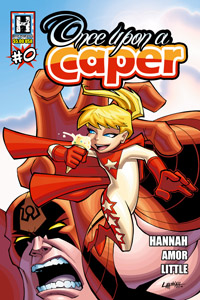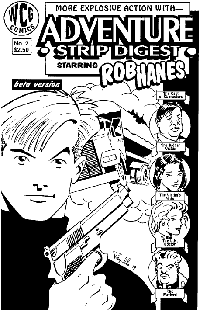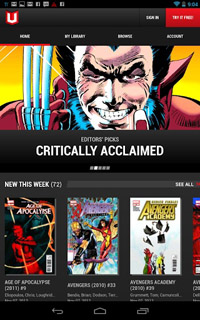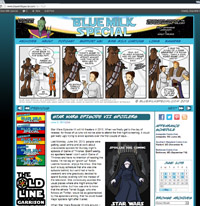Comic Conventions
Want to sit behind a table and promote your book to the foot traffic in Artist Alley? Artist Alley is the name for the section of a comic convention dedicated to lower cost tables for artists and writers to sell copies of the books, prints and merchandise. The price of a table is usually a lot less than an exhibitor booth, but the larger the convention the more they charge for a table. Small local shows are your best bet when you are starting out and learning what works and how to make the most of your investment. You need to consider your audience before jumping into a table registration.
Anime conventions work pretty much the same way as comic conventions, though you’ll find the attendees are much more open to independent comics. That is the drawback to comic conventions, the audience is a mix of families, teen geeks and older generation geeks, usually with a heavy investment in the Marvel and DC super hero universes. Few independent comics command the sort of loyalty from these readers of major titles like Batman, X-Men and so forth. If these readers have to make cuts to their comic book store pull list, then they are most likely going to prioritize their monthly fix of core Marvel and DC titles. Indie comics just don’t get as much engagement from this audience as they deserve. That’s why Anime cons are such a revelation for creators like Adam Whithers and Comfort Love, creators of Rainbow in the Dark and the Uniques. They were overwhelmed by the enthusiasm and interest of attendees at these shows.
Utilizing Your Space
The table is usually about 6′ ft long and bringing a table throw is a simple way to improve the presentation of your work and improve your table’s appearance. It’s a good idea to raise the eye-line a little, for example with a display stand for your books, or signage on table stands. You can also buy a vertical scroll banner, or create a PVC tube display stand to hang your banner or display your prints. I personally think artists at anime shows get a little too carried away creating a wall of their prints to hide behind. Much better to have a table that stands out from the rest than tries to hard and just becomes a blur of color.
My advice, don’t stand there yelling at passersby like you’re some mad circus ringmaster. There’s nothing more annoying than a loud mouth salesman trying to rope you into some sort of purchase or forced conversation. Let your signage and display catch their interest (put in the effort in your presentation) and if they make eye contact with you, then engage them with a smile and greeting and gesture at your work on the table with a wave of a hand. No pressure, just a friendly and quiet offer for them to check out your table on their own terms. Sometimes its good to look busy, sort through your supplies under the table or talk to your neighbors. This also seems to help attract passersby to take a peek without the threat of an immediate sales pitch. In fact, try not to be a salesman at all. Instead engage attendees at your table in friendly conversation about whereabouts they’re from and whether they are interested in your genre. No one wants to talk to an asshole or an uber-nerd, so as Han Solo would say: “I don’t know… Fly casual.”
Cons have hidden expenses. Food, travel costs, hotel costs, merchandise costs. It can be hard to make your money back at a larger show. Sometimes it might be better to think of such shows purely as a marketing / promotional investment. Your job is to get your name and your comic out there. Free flyers or promocards from OvernightPrints.com are one way to do that. There’s usually a table near the entrance where people can leave business cards, flyers and promo cards. Keep an eye on that table through the day as others will dump their cards over-the-top of yours as the table becomes full. You can correct this and makes sure yours are still visible by checking once or twice a day.
Hopefully, those people you meet will tell their friends and you will have tuned more people into your project for future online sales. Make sure you include your web address on everything.
Networking
After the show is over is often the best time to chat to fellow comic creators at the hotel bar or at dinner. It helps to get to know your table neighbors as well as other creators going through many of the same experiences as yourself. You can learn a lot and find ways to help each other. I usually like to get to the show to set up early and then have a quick wander through artist alley to see who else is there and what work they’ve brought with them. You usually get at least an hour or so to set up before the doors are opened to the general public. As for networking during the show, if you have a trusted friend who can watch your table for a short time (30 minutes to 1 hour) then you can scope out some of your fellow creator’s work and pick up a copy to support them.
Try not to leave your table for too long though. That one person who came to the show just to see you might miss you, plus it doesn’t look that great to leave your table unattended.
Survival Techniques
An easy way of transporting your gear (displays, table throw, art supplies, prints, books) from the car or hotel to the convention hall table is a wheeled-suitcase. However, as you become more experienced and ambitious you can buy a hand truck to wheel your supplies to and fro. If you have a table throw then you can hide the hand truck under the table when you’re done unloading. This is now just about the only way I can transport everything due to my spine issues.
Among those supplies, buy a six-pack, or larger, of bottled water. Also, bring snacks like crackers and cheese dip, cereal bars or sandwiches if possible. Convention catering is EXPENSIVE and usually not the best. Finding time to leave your table and run out to buy the food can also be difficult. Unless you have friends helping out, you may have to endure a very long day without a proper meal until dinner, so make sure you have those snacks.
Convention flu is real and often unavoidable around so many people. Let’s be honest, some of the attendees are going to have really poor hygiene and you just shook their hand. You can bring antibacterial hand soap along or just remember to wash your hands regularly. I know it sounds weird having to point this out, since most people seem to think they are immune, but having come back home with con flu in the past, you either heed the warning or learn it the hard way.
Part 1 – Introduction
Part 2 – The Harsh Realities
Part 3 – Making Webcomics
Part 4 – Promotion
I will be more than happy to answer any questions and ammend this article to help flesh out areas where I have been too brief. So feel free to comment or email me.





 Digital Comics: I offered
Digital Comics: I offered 